
Domestic travel in Korea during Chuseok
|
Su-hyeon and her friends get together for the first time in a while due to the COVID-19 pandemic. While talking about summer vacation, she discusses travel within Korea during the Chuseok (Korean Thanksgiving) holidays and useful tips for getting tickets. |
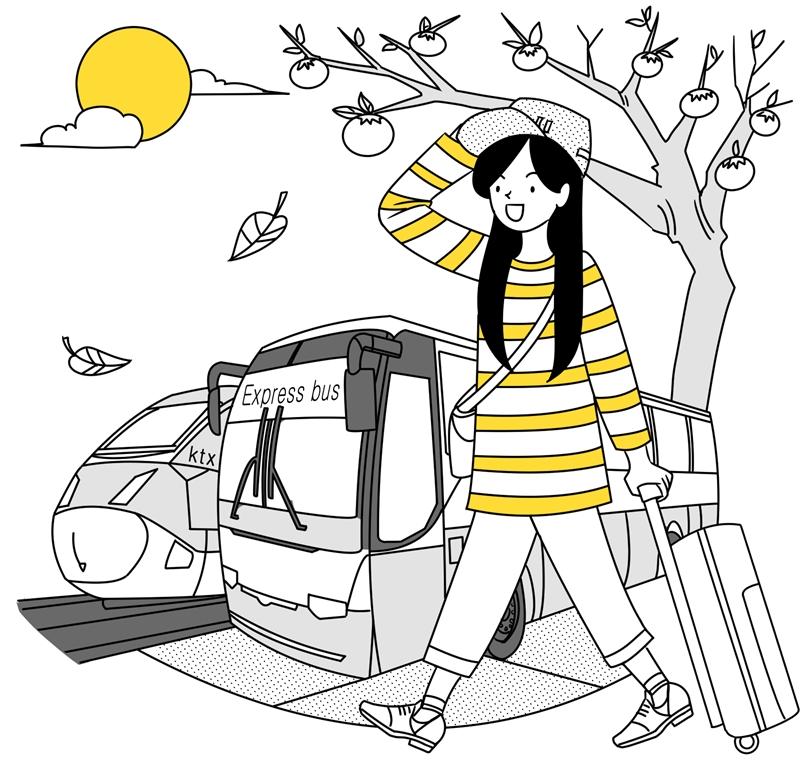
Su-hyeon: Hey, long time no see. It's been ages since I've seen all of you due to the coronavirus.
Jessie: How are you? Did you guys go on vacation this summer?
Huong: I planned to go to Busan for the Chuseok holidays last week but all train and airplane tickets were sold out.
Su-hyeon: Ah, that's because many Koreans usually visit their parents on Chuseok and Seollal (Lunar New Year).
Jacques: You mean many people want to buy tickets around those times?
Su-hyeon: Yes, that's a big reason. Another is that there's a certain period to make travel reservations for holidays.
Huong: I didn't know that. Where did you get this information?
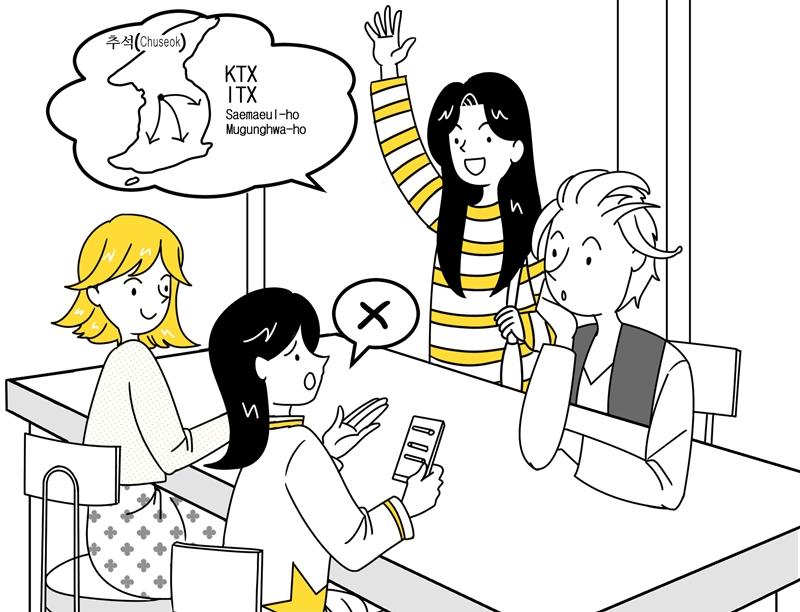
Su-hyeon: The notice is posted on the website of Korea Rail Corp. (KoRail) a month before each major holiday. It was much harder to get tickets this year because only window seats were available due to social distancing. So what do you know about taking the train in Korea?
Huong: When reserving a ticket, I found that riding the Mugunghwa-ho train takes twice as long as the KTX (Korea Train Express) bullet train.
Su-hyeon: Yes, but the Mugunghwa-ho is half the price of the KTX. The fastest and most expensive trains are, in descending order, the KTX, ITX (Intercity Train Express)-Saemaeul-ho and Mugunghwa-ho.
Jessie: Do all of the trains depart from the same station?
Su-hyeon: Yes, Seoul Station is the main station where most trains pass. A more limited selection of routes is at Yongsan and Cheongnyangni stations. Most trains at Yongsan Station go to the Honam region, whose destinations include Gwangju and Mokpo, Jeollanam-do Province. Cheongnyangni Station has lines headed toward the East Sea like Gangneung, Gangwon-do Province.
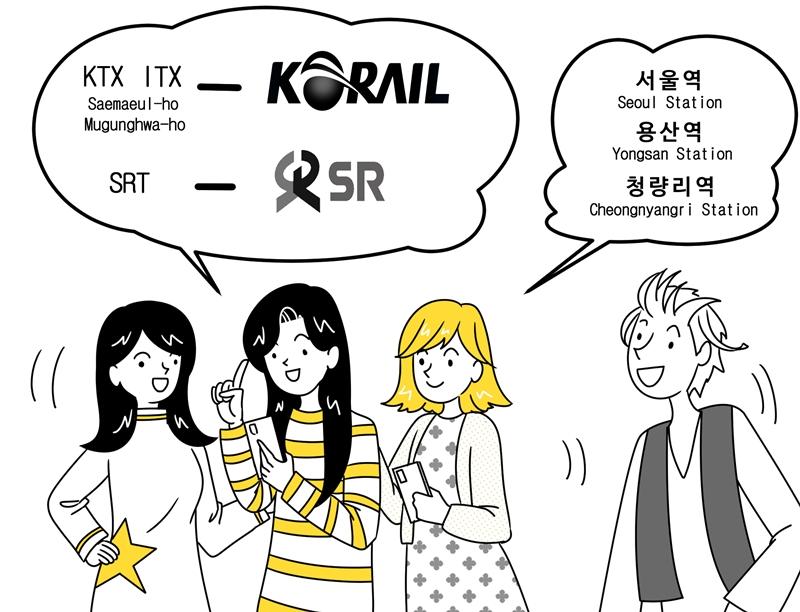
Jacques: So what's SRT (Super Rapid Train)?
Su-hyeon: SRT departs only from Suseo Station in southern Seoul. The KTX leaves from Seoul and Yongsan stations.
Jacques: Then the only difference between the KTX and SRT is the station of departure?
Su-hyeon: No, SRT is different from the KTX though their speeds and prices are almost the same and they share a few routes. Even their reservation websites are different.
Huong: That's right. Both types of trains also have separate reservation systems.
Su-hyeon: Yes. SRT's homepage is where you buy tickets for SRT, while those for the KTX, ITX-Saemaeul-ho and Mugunghwa-ho are available on KoRail's site.
Jessie: I see. How did you get your ticket this time? Any tips?
Su-hyeon: I barely got one. I used to buy tickets offline but couldn't this year because of COVID-19.
Jacques: It must've been tougher this year.
Su-hyeon: Getting a ticket due to a last-minute cancellation is another choice if you’re lucky.
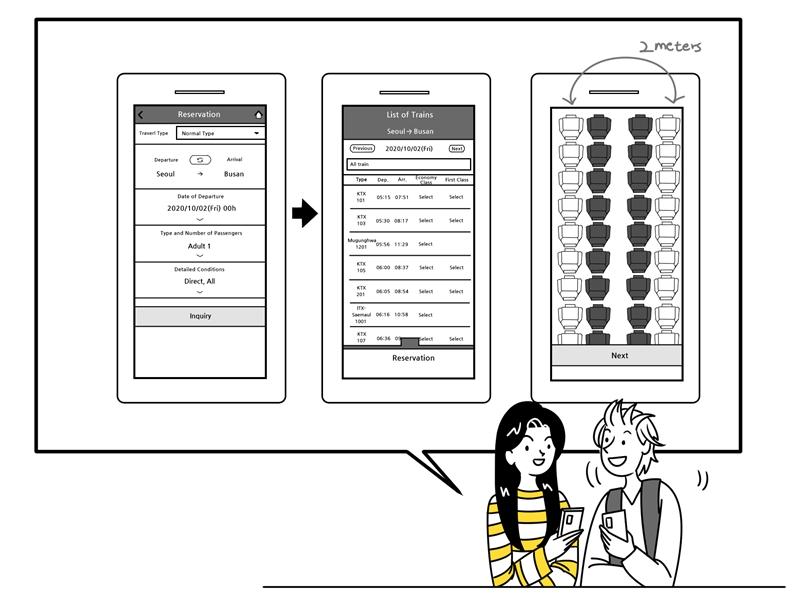
Jacques: Su-hyeon, I live near Express Bus Terminal in Seoul so I usually take an intercity express bus. Do buses also have a reservation period for holidays?
Su-hyeon: Of course. Reservations this year started from Aug. 24. Holiday seasons can see changes in point of departure, route and bus.
Jessie: How can I reserve a ticket?
Su-hyeon: It's the same as the train. Just see if your departure and arrival dates are available on the website or app and then make a reservation.
Huong: I went to Express Bus Terminal to take a bus last winter. It's very big, isn't it?
Su-hyeon: Yes, it is. In Seoul, Express Bus Terminal is the main hub for intercity bus travel, just like Seoul Station is where most people go to ride the train. The city also has Nambu, Dong Seoul and Sangbong bus terminals. Just be sure to check in advance because each terminal has different destinations.
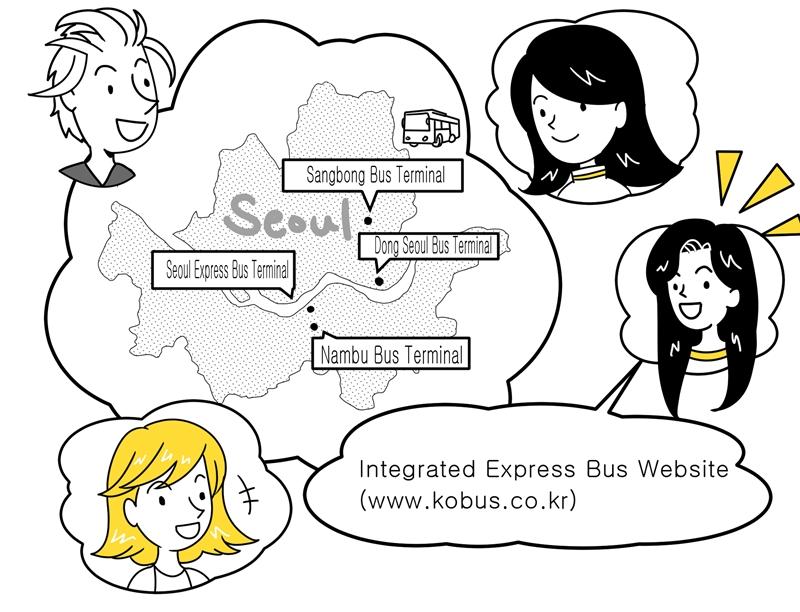
Jacques: What's cheaper and more convenient, the train or an express bus?
Su-hyeon: The KTX and SRT are definitively faster but more expensive than the bus. I recommend choosing the option closest to your house. In my case, I mostly take the train at Yongsan Station since it's the closest to my home.
Jacques: Wow, the websites for train stations and intercity bus terminals have information in English, Chinese and Japanese.
Huong: Oh, that's great.
Jessie: It's nice how the information is neatly organized. Thank you so much.
- Consultation available in English, Chinese and Japanese
- 365 days a year, 24 hours a day
• Integrated Express Bus website (www.kobus.co.kr)
- Consultation available in English, Chinese and Japanese
- 365 days a year, 24 hours a day
• bbb Korea: 1588-5644 (www.bbbkorea.org)
- Consultation available in English, Japanese, Chinese, French, Spanish, Italian, Russian, German, Portuguese, Arabic, Polish, Turkish, Swedish, Thai, Vietnamese, Indonesian, Mongolian, Hindi, Malay and Swahili
- 365 days a year, 24 hours a day
• 1345 Immigration Contact Center: 1345 (www.hikorea.go.kr)
- Consultation available in Korean, Chinese, English, Vietnamese, Thai, Japanese, Mongolian, Indonesian, French, Bengali, Pakistani, Russian, Nepali, Khmer, Burmese, German, Spanish, Filipino, Arabic and Sinhala
- 09:00 to 22:00 on weekday (After 18:00, only Korean, English and Chinese available)
• Korea Travel Hotline service: 1330 (english.visitkorea.or.kr)
- Consultation available in Korean, English, Japanese, Chinese, Russian, Vietnamese, Thai, Malay and Indonesian
- 365 days a year, 24 hours a day
• Danuri Helpline: 1577-1366 (www.liveinkorea.kr)
- Consultation available in Korean, English, Chinese, Vietnamese, Filipino, Khmer (Cambodian), Mongolian, Russian, Japanese, Thai, Lao, Uzbek and Nepali
- 365 days a year, 09:00 to 18:00
Written by Kim Minji
Translated by Cho Ahyoung and Ju Eunjin
Illustrated by Yuhaill
kimmj7725@korea.kr
![[While in Korea] Episode 3 – Driving in Korea](/upload/content/image/1556760396224.jpg)
![[While in Korea] Episode 2 – Opening a bank account](/upload/content/image/1554117679477.jpg)
![[While in Korea] Episode 19 – Traditional Korean medicine](/upload/content/image/f46d1de529a04b8682b2345a93c86020_20200903093718.jpg)
![[While in Korea] Episode 18 – Interpretation services for foreigners in Korea](/upload/content/image/79d305027ac04fe1be725e116c5ebdcc_20200803153630.jpg)
![[While in Korea] Episode 17 – Enjoying Korean food as a vegan](/upload/content/image/ccfc24f9dab1436ea0860c6a27b7a16f_20200704164831.jpg)
![[While in Korea] Episode 16 – Quarantine process when entering Korea](/upload/content/image/c6a93f0a347648d6ac04fb26060fd598_20200604133413.jpg)
![[While in Korea] Episode 15 – 'Distancing in daily life' amid COVID-19 pandemic](/upload/content/image/69b3e61a9e2749d9b4800bcea8c0f4fd_20200504155216.jpg)
![[While in Korea] Episode 14 – Finding housing in Korea](/upload/content/image/b94e637477824e2a95ca9b6688429864_20200406095850.jpg)
![[While in Korea] Episode 13 – Protecting yourself against the COVID-19 outbreak](/upload/content/image/2388ed0618d249bfad30bd699f0f14f3_20200306133100.jpg)
![[While in Korea] Episode 12 – Year-end tax settlement](/upload/content/image/2596d72317b84859ace4ae71f3819d6b_20200206093350.jpg)
![[While in Korea] Episode 11 – New year's customs](/upload/content/image/a1abe1881c584a59b382c608d709ea49_20191230132857.jpg)
![[While in Korea] Episode 10 – Kimjang culture](/upload/content/image/919788d87e89464cac5ef8289c6ac535_20191204132222.jpg)
![[While in Korea] Episode 9 – Seshin and bathhouse culture](/upload/content/image/1d05570c6db54137b0a2e9fa11068b3f_20191106144320.jpg)
![[While in Korea] Episode 8 – Work tips for int'l students](/upload/content/image/1570155627700.jpg)
![[While in Korea] Episode 7 – Table manners](/upload/content/image/1568076457016.jpg)
![[While in Korea] Episode 6 – Proper etiquette at special events](/upload/content/image/1565157913682.jpg)
![[While in Korea] Episode 5 – Where to escape the summer heat](/upload/content/image/1561974297462.jpg)
![[While in Korea] Episode 4 – What to do in case of emergency](/upload/content/image/1559527330239.jpg)
![[While in Korea] Episode 1 - Getting mobile phone service](/upload/content/image/1552959724998.jpg)